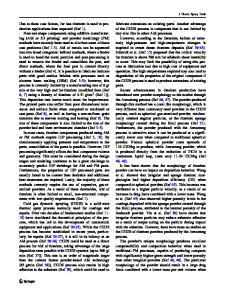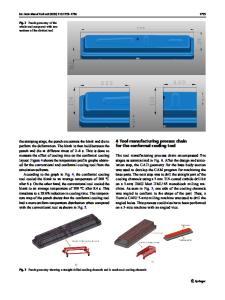Manufacturing of Titanium Bipolar Plates Using Warm Stamping Process
- PDF / 1,442,202 Bytes
- 7 Pages / 595.276 x 790.866 pts Page_size
- 70 Downloads / 381 Views
RESEARCH ARTICLE-MECHANICAL ENGINEERING
Manufacturing of Titanium Bipolar Plates Using Warm Stamping Process Vahid Modanloo1
· Vali Alimirzaloo1 · Majid Elyasi2
Received: 15 January 2020 / Accepted: 13 August 2020 © King Fahd University of Petroleum & Minerals 2020
Abstract A titanium bipolar plate for fuel cell not only has excellent corrosion resistance but also has a lower density than stainless steel bipolar plates. However, titanium exhibits low formability at room temperature that requires warm forming as a prominent solution to overcome this drawback. The present study investigates the forming of bipolar plates for the proton exchange membrane fuel cell out of commercially pure titanium ultra-thin sheet. In this regard, the formability of the titanium sheet with a thickness of 0.1 mm was first evaluated through the tensile test at different deformation temperatures and speeds. Also, V-die bending experiments were carried out at room and warm temperatures to examine springback of the sheet. Afterward, a warm stamping setup was conducted to fabricate the titanium bipolar plates in the range from room temperature to 200 °C with stamping speed varying between 0.6 and 4.8 mm/min. Accordingly, the formed samples were analyzed and their forming rate, thinning rate, and springback were discussed. The results indicated that the formability of the titanium sheet depends on both forming temperature and speed. The most elongation of the sheet was obtained at a temperature of 100 °C and a deformation speed of 0.6 mm/min. The maximum channel depth was obtained equal to 0.494 mm using a warm stamping process that implies an improvement by 40% in the filling rate of microchannels compared with forming at the room temperature. Likewise, the dimensional error of the titanium bipolar plate due to the springback was decreased by stamping at 100 °C compared with forming at room temperature. Keywords Formability · Titanium · Bipolar plates · Warm stamping · Springback
1 Introduction In recent years, proton exchange membrane fuel cells (PEMFCs) are considered as a clean power source for transportation applications especially automotive. However, their widespread commercialization is limited due to some barriers including cost, mass, and duration. Bipolar plates (BPPs) are the key components of a fuel cell from weight and cost points of view. Compared to conventional BPPs, i.e., graphite and composite, metallic types have received much attention because of their ease of production and excellent physical properties [1–3]. Presently, the common metallic materials used to fabricate BPPs are stainless steel, Al, and
B
Vahid Modanloo [email protected]
1
Mechanical Engineering Department, Faculty of Engineering, Urmia University, Urmia, Iran
2
Mechanical Engineering Department, Babol Noshirvani University of Technology, Babol, Iran
Ti alloys. There are some important criteria based on DOE (department of energy) that should be taken into consideration for a suitable BPP [4] such as corrosion resistance, chemical stability
Data Loading...











